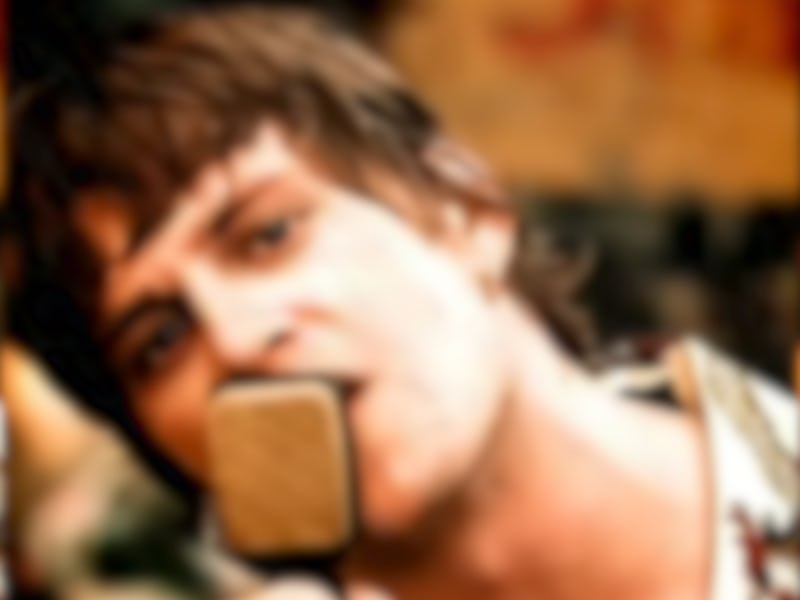Pet Vision Study Shows How Elon Musk, Rob Thomas & Chewbacca Look to Cats
So much for sharp-sightedness.

Friends who have cats will always tell you how good their cat is at catching pests. These people never seem to have rodents or mice in their homes, which they sometimes chalk up to the sharp-sightedness of their pets. But contrary to what these gloating cat parents might tell you, a new study in Trends in Ecology & Evolution shows that the eyesight of cats — and hundreds of other animals — is actually even blurrier than ours.
The paper includes simulated images of what a cat — or a human, goldfish, rat, fly, or mosquito — would see when looking at the same living room scene. The images were created using AcuityView, a software developed by the team using data on visual acuity — that’s the sharpness or clarity of vision — for over 600 species of animals. Some observations were unexpected, says Duke University visual ecologist Eleanor Caves, Ph.D., who led the team.
Caves used AcuityView to show Inverse what Elon Musk, Rob Thomas of “Smooth” fame, Chewbacca, and the cast of Avengers: Infinity War might look like to a cat — which you can see below.
“What was most surprising to me was just the sheer number of animals that have vision with far lower acuity than we do,” Caves tells Inverse in an e-mail. Generally speaking, large primates and large mammals have vision that’s roughly as sharp as ours, but body size isn’t the only factor that comes into play when it comes to acuity.
“[Even] in fish, predatory animals that can be quite large, the highest recorded acuity is only half as sharp as ours, and most insects (which represent a huge part of the biodiversity on the planet) have incredibly coarse vision compared to ours,” she says.
Here's what the same scene looks like for several animals, including humans.
What’s Acuity Anyway?
Acuity is important because it measures the level of detail the visual system can extract from a scene; in the wild, where sneaky predators abound, acuity can be extremely important indeed. On Instagram, acuity is the part of the image you adjust using the ‘Sharpness’ tool. It’s also what optometrists talk about when they refer to “20/20” vision: If you get that perfect score, it means you have perfect acuity.
Acuity is generally measured in “cycles per degree” (cpd), a unit that stems from the classic test of acuity shown below. “Cycles,” here, refers to pairs of black-and-white stripes; “degree” is simply a measure of visual angle. Essentially, the more increasingly thin “cycles” you can see in that visual wedge before it turn into a grey smear, the higher your acuity is.
The higher your visual acuity, the better you are at discerning individual pairs of black-and-white stripes.
Humans: Sharper Than Most
Humans, we’ve determined, have a peak visual acuity of about 60 cpd. This lets us see things that are far away, like traffic signs and faces, though we’re not nearly as good as, say, super-predator birds like the wedge-tailed eagle of Australia, which has a visual acuity limit of 140 cpd. But humans, in most instances, don’t need to be able to catch a rabbit from 1,000 feet in the air.
The study, however, turned up many other animals that have low visual acuity where you might expect it to be at least higher than ours. Many were birds: With the exception of several eagles, vultures, and falcons, the highest recorded acuity in a bird was the measly 41 cpd measured in the laughing kookaburra. Among fish, the large predatory rock bass (40 cpd) and Atlantic sailfish (32 cpd) ranked the highest, but even these were quite coarse compared to humans. Insects had pretty low acuity as well: At an acuity of only 13 cpd, the jumping spider was among the sharpest-eyed.
Acuity isn’t the only determinant of vision, says Caves, noting that humans post-process images in their brains after perceiving them. “We know very little about pattern processing in animals, so it may be that animals with low acuity have some edge sharpening, etc. that will make their world less blurry than in our modeled photographs.” Additionally, quickly moving objects might seem more conspicuous than stationary ones, and the sense of smell is of course very important for some animals.
That might explain why your friend’s cat, whose vision is only about one-sixth as fine as yours, can catch those mice.
What Cats See
Caves ran AcuityView on a series of images that a cat might see at or around the Inverse office. (We would’ve done dogs, but she says there aren’t any good data for dogs yet). Since images appear sharper when you’re up close and details fade as you get further away, she modeled the images in the slideshow below at distances reasonable to the scenario.
There are a number of reasons cats can’t see these images so clearly, though depending on who you ask, they aren’t missing much. “[Cats], which are nocturnal, might have eyes that are more sensitive to light so that they can see at night, while sacrificing some acuity,” says Caves. “In the end, the primary limiting factor on acuity is the size of the eye, so many animals are just constrained in how high their acuity can be because of their eye size!”
Caves is hoping that better understanding the acuity of animals will give us a better idea of how the world looks through an animal’s eyes. She admits, however, that her software gives us only a “best guess” of what animals see. “[There] are more unanswered questions than answered ones, making it an exciting time to start thinking about acuity!”
Doesn't look like anything to me.
To this cat, the Hulk may as well be a bush.
Still unmistakably Chewie.
Still smooth.